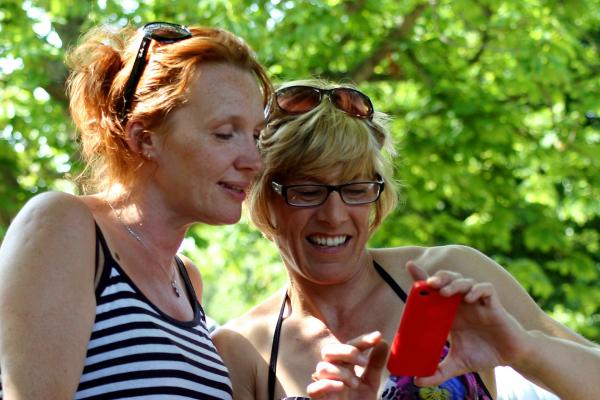Monkey See, Monkey Do
The underlying reason for our social ways, captured in that simple phrase about monkeys, are mirror neurons. These are neurons within our brain that fire both when we do an activity and when we see someone else doing the same action – so at least monkey see, monkey’s neurons get excited. Their heyday, in the popular media, was roughly 2013. As the authors of one review write,
“The discovery of mirror neurons has had a profound effect on the field of social cognition.” [1]
They also point out the chicken-egg problem with mirror neurons, were they already in place at birth, or do they develop as we learn and grow. We can safely leave that issue to the researchers; suffice to say, there are unconscious physiologic actions that support our social nature.
Entrainment, synchronizing our behavior, has been demonstrated for the speech between romantic couples – their speech becoming more similar in pitch, loudness, or speaking rate. My “stubby” (shorter) legs entrain with the longer legs of my wife when we walk, another universal behavior of humans.
The Tell-Tale Heart
It is no surprise that our heart rate varies; anyone who has moved furniture into a second-floor walkup apartment can tell you that. And those who meditate and deliberately slow their breathing can report that their heart rate slows in response to our respiratory rate. Both of these “stimuli” are physical, the exertion of the stairs and the alteration of vagal tone with conscious breathing. It turns out that, as in the case of the mirror neurons, seeing and hearing also alters our physiology, in this instance, heart rate.
A moment of background science – Our heart rate fluctuates from beat to beat. When our heart rate is recorded, and we are told it is 60, 75, or 110, that is the beats counted over time, usually per minute. You will get a slightly different count if you use a shorter period, say between two heartbeats. Measuring for a minute, aggregates and “smooths” out each of those variations. Heart rate variability, the beat-to-beat change, is a physiologic level we can measure, summing up many underlying functions, heart disease, stress, vagal tone, respiratory rate, etc. You want variability because it means your body is resilient to change, making minor corrections to your circulation. A stable, unchanging heart rate variability is a sign of significant physiologic distress and heart disease. OK, back to the story.
The Study
Researchers wanted to study whether narratives, be they print stories or movies, could actually be “heartfelt.” [2] To relieve your heart of the stress-induced changes of not knowing, the answer is yes.
Over the course of several experiments, they presented “narrative stimuli” (audiobooks or instructional videos) to young adults while recording their heart rate by electrocardiogram and their respiratory rate. In the case of an audiobook, that “thriller” Twenty thousand leagues under the sea, the participants did vary in the same direction, at the same point in the story. They found the same entrainment of heart rate with video, in this case, 3-5 minute “heart-pounding” instructional videos on biology, physics, and computer science.
They found that the entrainment was lost when the participants were distracted, say by counting backward by 7. They also determined that it was not synchronous breathing that most heavily influenced heart rate; it seemed to be the story itself.
The researchers concluded that hearing a narrative would elicit alterations in our heart rate and heart rate variability.
More importantly, individuals had similar responses in their heart rates as the narrative unfolded, and that it wasn’t necessary for all the participants to hear the story at once. The changes from narration were similar for individual one and two even though they listened hours or days apart. They had hoped that for a segment of comatose patients, who appeared to be less than conscious, but more than vegetative (with no hope of a return of meaningful brain function), playing these narratives would identify them so that we might be more aggressively treated. Alas, that proved not to be the case. Evidently, the inattention of coma was sufficient to eradicate the entrainment of heart rate.
What’s in it for me?
If I have not induced coma in you with my words so far, I think there is a very interesting possibility. Stories, as this work clearly shows, can alter our physiologic responses. There might well be physiologic changes from a “feel-good” story. Scary stories can arouse physiologic changes consistent with fear. Moreover, it seems that we all tend to respond if we are paying attention, in very similar ways to the same story, whether we hear it with our friends or listen to it a day or so later. Stories are pretty powerful.
Now consider the most remarkable story machine of all time, social media. The digital form of storytelling, news, gossip, crazy Ernie’s theory (dare I include mine?) has scaled from one-to-one or one-to-five or six to one-to-thousands upon thousands. We know that stories change our physiologic responses; social media, which we voluntarily attend to for hours a day, are stories too. Could your social media alter your physiology to make you feel good, bad, or stressed? Could a steady diet of scary news evoke a fight or flee physiologic response? If you “follow the science,” at least in this study, the answer, it seems to me, is yes.
[1] What We Know Currently about Mirror Neurons Current Biology DOI: 10.1016/j.cub.2013.10.051
[2] The actual goal of the study was whether “conscious processing of perceptual information will affect heart rate.” They were hoping to find a way to determine “consciousness” in those individuals in coma; they did not
Source: Conscious processing of narrative stimuli synchronizes heart rate between individuals Cell Reports DOI: 10.1016/j.celrep.2021.109692




